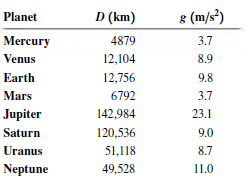For a spherical planet with mass M, volume V, and radius R, derive an expression for the
Question:

(a) Treat the planets as spheres. Your equation for g as a function of r and D shows that if the average density of the planets is constant, a graph of g versus D will be well represented by a straight line. Graph g as a function of D for the eight major planets. What does the graph tell you about the variation in average density?
(b) Calculate the average density for each major planet. List the planets in order of decreasing density, and give the calculated average density of each.
(c) The earth is not a uniform sphere and has greater density near its center. It is reasonable to assume this might be true for the other planets. Discuss the effect this nonuniformity has on your analysis.
(d) If Saturn had the same average density as the earth, what would be the value of g at Saturn€™s surface?
Step by Step Answer:

University Physics with Modern Physics
ISBN: 978-0133977981
14th edition
Authors: Hugh D. Young, Roger A. Freedman





